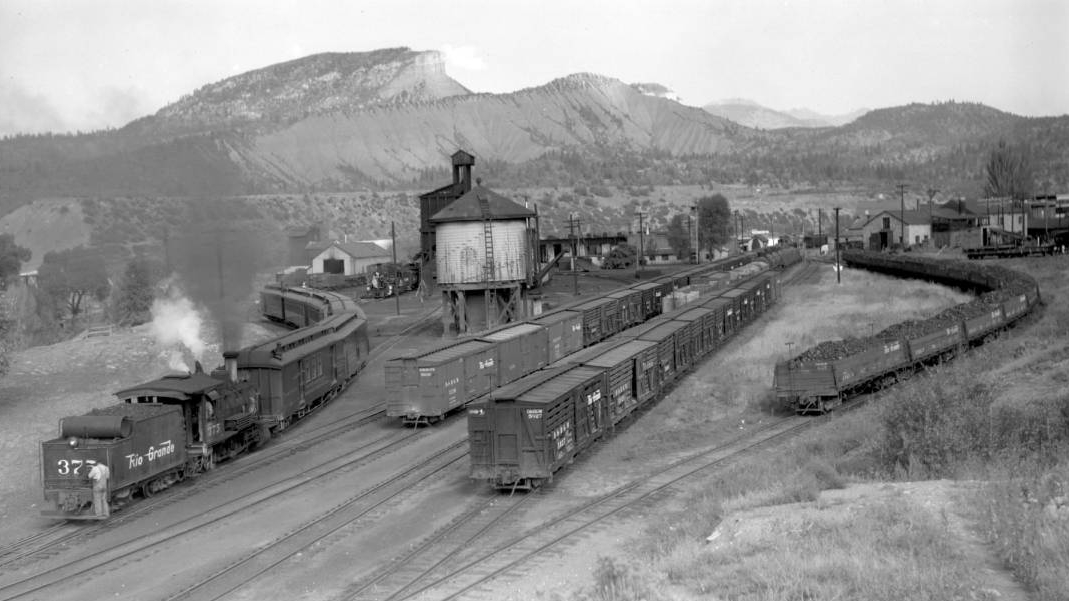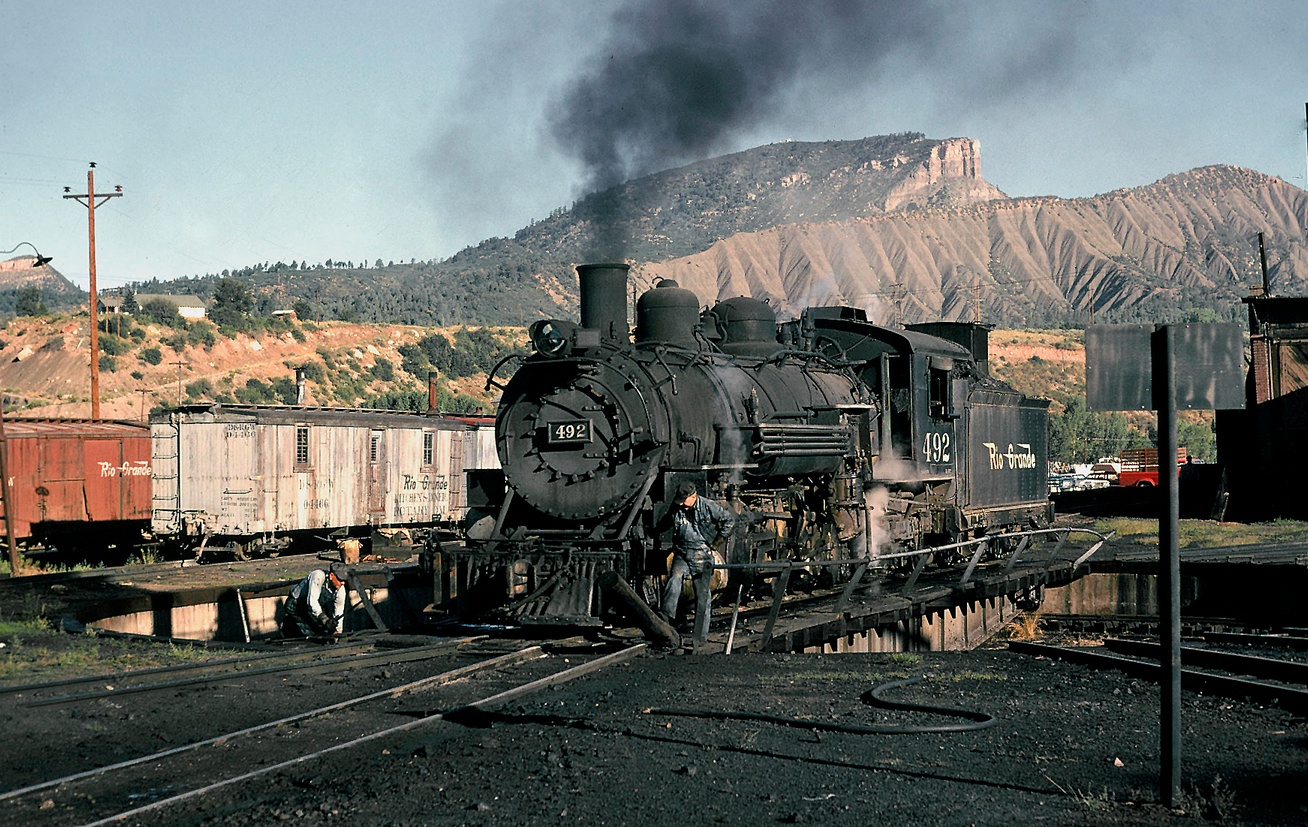The original roundhouse was constructed in 1882. It was built of red brick with timber roof framing. There were 10 stalls for the locomotives. In 1905 stalls 9 and 10 were modified for standard gauge locomotives. Then in 1951 stall 1 was converted to storage. Stalls 1 through 4 were demolished in 1971 and stalls 7 through 10 were remodeled to accommodate doghouse tenders.
In 1989, a fire destroyed most of the roundhouse. The next year it was rebuilt by the D&SNG. The new model has 18 stalls and a large shop extension on the north side. The rebuilt version has sections that are done in the original brick style in the areas where the original roundhouse stood. The additional 8 stalls on the south end have a more modern brick facia.
Perhaps the most famous piece of equipment on the D&SNG railroad is the operating turntable and its accompanying roundhouse. This marvelous machine is used to spin the locomotives around so they can go the other direction on the tracks.
In the 1924 the original 50 feet turntable bridge was changed to a 65 feet model. The new unit had riveted plate girder beams built by the Chicago Bridge and Iron Company and a concrete pit. It was brought over from Alamosa and could carry larger K-series locomotives.
The turntable was powered by attaching a hose to the air supply of a locomotive. The air runs a motor on the turntable bridge.
Source: Sandia Software
On August 5, 1881 the Denver & Rio Grande Railway arrived in Durango, Colorado. The new town was founded by the D&RG in 1880 chiefly through the talents and organization of General Palmer’s business partnerDr. William Bell. Construction to Silverton, Colorado began that fall. Only 11 months later, the D&RG reached Silverton on July, 10 1882. Trains hauling passengers and freight began immediately. The Denver & Rio Grande Railway soon re-emerged as the Denver and Rio Grande Railroad (1886) and ultimately began operating as the Denver & Rio Grande Western Railroad (D&RGW) on July 31, 1921 after re-organization of the Colorado lines and Rio Grande Western of Utah. Eventually, the railroad became widely known as the “Rio Grande”.

Roundhouse and yards, with 375 switching. Photographed: Durango, Colo., October 2, 1947. Denver Public Library.
The Silverton branch, as it became known, struggled under D&RG ownership following the panic of 1893 and the end of free coinage of silver. Typical of many portions of the surviving narrow gauge branches into the middle of the twentieth century, the line faced sagging revenue due to ever declining mining ventures, highway trucking competition, and insignificant passenger revenue. Annual snowslides and several major floods on the branch would only continue to challenge the railroad’s ability to survive.
After World War II, domestic tourism began to grow across the country, and the Silverton branch of the D&RGW would benefit. Bolstered by national exposure via Hollywood movies being filmed along the line in the late 1940s, the D&RGW began to see a gradual increase in passenger traffic on the mixed train to Silverton. In 1950, the railroad adorned a locomotive and four coaches with a colorful paint scheme and launched modest public promotion. With this effort, “The Painted Train” officially started a new era of tourism that continues to this day. Freight traffic, however, continued to decline and by the early 1950s, year round operations had ceased and only the summer tourist traffic and very light freight business would be handled on the mixed trains during summer months.
By the 1960s, the modern and efficient D&RGW did not see the Silverton Branch as worthy to maintain and a petition was filed with governmental agencies to abandon the route. The ICC declined to grant the request due to the continued increase in tourist patronage. Following the ICC’s ruling, the railroad reluctantly responded by investing in additional rolling stock, track maintenance, and improvements to the Durango depot. The railroad purchased some of the property around the depot, cleaned up the block extending north to Sixth Street, and facilitated the opening of gift shops and other tourist friendly businesses. The area was now christened “Rio Grande Land”. A second daily train to Silverton was added in 1963, and the ridership continued to grow.
Since 1971, this line and the line that is now the Cumbres and Toltec Scenic Railroad had been the only remnants of what was once an extensive Rio Grande narrow-gauge network. All the while, the Rio Grande was actively trying to sell the line, and in 1979 Charles Bradshaw, a Florida citrus grower, offered the D&RGW a legitimate opportunity to divest itself of its antiquated and isolated line as negotiations began for purchase of the Silverton. As history would have it, October 5 of 1980 would mark the last departure of the Silverton under Rio Grande management. After a work train operated the following day and returned to Durango, the Denver and Rio Grande Western was finished with narrow gauge train operations.





